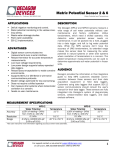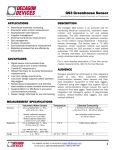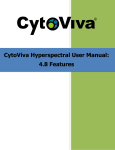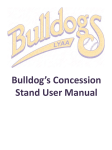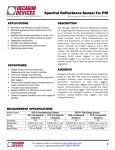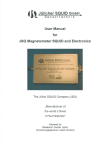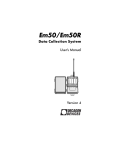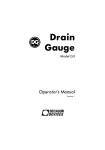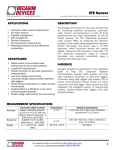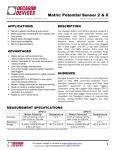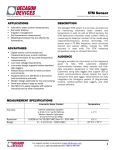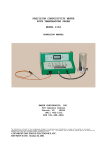Download Manual-Drain Gauge-E..
Transcript
Drain Gauge Gee Passive Capillary Lysimeter User’s Manual Version 1.0 Decagon Devices, Inc. ©2003 Decagon Devices, Inc. All rights reserved. 950 NE Nelson Court Pullman WA 99163 USA Drain Gauge User’s Manual Table of Contents Contents 1. Introduction . . . . . . . . . . . . . . . . . . . . . . . . . . . . . 1 Welcome . . . . . . . . . . . . . . . . . . . . . . . . . . . . . . . 1 Drain Gauge Specifications . . . . . . . . . . . . . . . 1 Contact Information . . . . . . . . . . . . . . . . . . . . . . 1 Warranty Information . . . . . . . . . . . . . . . . . . . . 1 Seller’s Liability . . . . . . . . . . . . . . . . . . . . . . . . . . 2 2. The Drain Gauge . . . . . . . . . . . . . . . . . . . . . . . 3 About the Drain Gauge . . . . . . . . . . . . . . . . . . . 3 How it Works: . . . . . . . . . . . . . . . . . . . . . . . . . . . 3 Features . . . . . . . . . . . . . . . . . . . . . . . . . . . . . . . . 4 Wiring Diagrams . . . . . . . . . . . . . . . . . . . . . . . . . 5 Extension cables . . . . . . . . . . . . . . . . . . . . . . . . . 6 General Theory and Considerations . . . . . . . . . . . . . . . . . . . . . . . . . . . . . . 6 3. Installing the Drain Gauge . . . . . . . . . . . . . 10 Location Preparation . . . . . . . . . . . . . . . . . . . . 10 Excavation . . . . . . . . . . . . . . . . . . . . . . . . . . . . . . 11 Installation - Wick Section . . . . . . . . . . . . . . . 12 Installation - Divergence Tube . . . . . . . . . . . . 13 Installation-Valve Box . . . . . . . . . . . . . . . . . . . 14 Calibration and Testing . . . . . . . . . . . . . . . . . . 15 Troubleshooting . . . . . . . . . . . . . . . . . . . . . . . . 15 Data Analysis . . . . . . . . . . . . . . . . . . . . . . . . . . . 16 Calculating Drainage . . . . . . . . . . . . . . . . . . . . 16 Solution Sampling . . . . . . . . . . . . . . . . . . . . . . . 17 Monitoring and Equilibration . . . . . . . . . . . . . 17 Water Balance . . . . . . . . . . . . . . . . . . . . . . . . . 17 References . . . . . . . . . . . . . . . . . . . . . . . . . . . . . 18 i Drain Gauge User’s Manual Table of Contents 4. Collecting Data . . . . . . . . . . . . . . . . . . . . . . . . 19 Datalogger Requirements . . . . . . . . . . . . . . . . 19 Connecting to a Datalogger . . . . . . . . . . . . . .20 Sample Program . . . . . . . . . . . . . . . . . . . . . . . .20 Troubleshooting . . . . . . . . . . . . . . . . . . . . . . . . 29 Declaration of Conformity . . . . . . . . . . . . . . .30 ii Drain Gauge User’s Manual Introduction 1. Introduction Welcome Thank you for purchasing the Drain Gauge. This innovative instrument will enable you to monitor soil water movement and chemical leaching accurately and affordably. Drain Gauge Specifications Total height: 150cm Top opening width: 20cm Length of divergence control zone: 66cm Length of pipe: 81cm Drain diameter: 4.2cm Connector type: 3.5 mm plug Datalogger Compatibility (not exclusive): • Decagon Em5, Em5R • CSI: CR10, CR10X, 21X, 23X, CR7, CR200 Family Contact Information • Email: [email protected] • Fax: (509) 332-5158 • Phone: 1-800-755-2751 (US and Canada only) or 509-332-2756. Warranty Information The Drain Gauge has a 30-day satisfaction guarantee and a one-year warranty. 1 Drain Gauge User’s Manual Introduction Seller’s Liability Seller warrants new equipment of its own manufacture against defective workmanship and materials for a period of one year from date of receipt of equipment (the results of ordinary wear and tear, neglect, misuse, accident and excessive deterioration due to corrosion from any cause are not to be considered a defect); but Seller’s liability for defective parts shall in no event exceed the furnishing of replacement parts F.O.B. the factory where originally manufactured. Material and equipment covered hereby which is not manufactured by Seller shall be covered only by the warranty of its manufacturer. Seller shall not be liable to Buyer for loss, damage or injuries to persons (including death), or to property or things of whatsoever kind (including, but not without limitation, loss of anticipated profits), occasioned by or arising out of the installation, operation, use, misuse, nonuse, repair, or replacement of said material and equipment, or out of the use of any method or process for which the same may be employed. The use of this equipment constitutes Buyer’s acceptance of the terms set forth in this warranty. There are no understandings, representations, or warranties of any kind, express, implied, statutory or otherwise (including, but without limitation, the implied warranties of merchantability and fitness for a particular purpose), not expressly set forth herein. 2 Drain Gauge User’s Manual The Drain Gauge 2. The Drain Gauge About the Drain Gauge The Drain Gauge is designed to be installed in the ground for long-term monitoring, with an estimated minimum 10-year lifetime. The Drain Gauge also has a collection system that allows for rapid sampling of drainage waters. How it Works: 1. The Drain Gauge is installed below the root zone. 2. Water infiltrates down through the divergence control tube, and then down a speciallydesigned fiberglass wick into a collector. 3. The water fills the height of the collector, and the water level is monitored by a an electronic water level gauge. 4. A sampling syringe, attached to the water reservoir sampling port, can draw water samples out for chemical analysis. 5. When the water level reaches the top of the siphon tube, the water empties and the change in water volume is recorded by an attached datalogger. The emptied water drains out the end of the apparatus and back into the soil. 3 Drain Gauge User’s Manual The Drain Gauge Features Em5 Sampling Syringe Divergence Control Tube (Removable) Sheath Wick Siphon Water Level Gauge Water Reservoir Sampling Port Drain Fig.1: Drain Gauge probe diagram 4 Drain Gauge User’s Manual The Drain Gauge Wiring Diagrams 3.5mm plug wiring The Drain Gauge’s moisture sensor comes with a 3.5mm “stereo-plug” style connector. This allows for rapid connection directly to Decagon’s Em5 data logger. Below is a diagram showing the wiring configuration for this connector. Analog out Ground Excitation Fig. 2: Sensor plug wiring configuration Adapter cable wiring The sensor adapter cable for connection to nonDecagon equipment contains 3 wires as shown below. The cable plug has integrated inductors designed to provide signal noise reduction. Analog out (Red) Ground (Bare) Adapter cable Excitation (White) Fig. 3: Adapter cable wiring configuration 5 Drain Gauge User’s Manual The Drain Gauge NOTE!: Be aware that cutting off the cable plug or cutting the cable in any other way will void your warranty, since the plug and cable are both specially engineered for optimal performance and noise reduction. Extension cables Decagon supplies 50-foot (15.25m) and 10-foot (3m) extension cables to attach to the sensor cable. You can safely connect up to 3 of the 50-foot cables without signal attenuation. For most applications, you will want to seal the connections from the elements to maintain a good connection and to prevent corrosion. Decagon provides heat-shrink with all extension cables upon request. To seal a connection between two extension cables using the heatshrink, simply ensure that the heatshrink is covering the connection, then heat it using a heat-gun, blowdryer or a lighter until it shrinks tight to the connection. Note: If using a lighter, place the heatshrink well above the flame to avoid melting the heat shrink and the connector. General Theory and Considerations A soil water balance takes into consideration the inputs, losses and storage of water in a soil profile. An important component of the water balance is the water that drains from the bottom of the soil profile, often referred to as "deep drainage" or "deep percolation." This is water that has gone sufficiently far below the root zone that it cannot be removed from 6 Drain Gauge User’s Manual The Drain Gauge the soil by transpiration or evaporation. The other components of the water balance can be measured, but the deep drainage typically has been computed as the remainder when the other components were measured and accounted for. Because of uncertainties in the measurements of the other water balance components, deep drainage estimates were subject to large errors. The Drain Gauge now allows direct measurement of the deep drainage component of the water balance. This is accomplished by intercepting and collecting the water that moves below the root zone. The Drain Gauge is sometimes referred to as a passive wick lysimeter. It has a specially treated fiberglass wick which maintains a tension on the water at the bottom of the soil profile from which it is extracting water. Without this tension, water would "pile up" at the outflow boundary, and force the water in the soil above to move around the Drain Gage, rather than into it. The divergence control tube on the top of the Drain Gage is also for the purpose of maintaining vertical flow above the Gauge so that the Drain Gage intercepts a representative sample. Both the amount of sample and its chemical composition need to be representative of deep drainage in the area in which the drain gage is installed. Whether or not this is true is determined largely by the installation. The main issues are: 1. Depth of installation 2. Soil disturbance above the Drain Gauge. 7 Drain Gauge User’s Manual The Drain Gauge 3. Contact between the wick and the soil profile. Following are some general comments related to these issues. Specific installation procedures are then outlined in the next chapter. Depth of Installation In any soil profile, there is a zone of recharge and seasonal depletion extending to the bottom of the root zone. Since root density decreases with depth, the bottom of this zone may be difficult to locate. In annual crops it is typically around 1 m, but can be much deeper in perennials. There is, of course, a practical limit to how deep the Drain Gauge can be installed. With shallow-rooted crops this is not an issue, but with deep-rooted plants, one may need to strike a compromise between getting below all roots and installing the Gauge at a practical depth. Even when roots go quite deep, the amount of water taken up by these roots may be quite small. Another consideration is the depth of the water table. The water table depth must always be below the bottom of the Drain Gauge so that water can drain out. This might sometimes require that the Drain Gauge be installed at a shallower depth than would be ideal to accommodate the root zone. The consequence of installing the Drain Gauge at too deep a depth is that it will require a long time to come to steady state and give drainage numbers that are representative. The consequence of installing it at too shallow a depth is an over-estimation of 8 Drain Gauge User’s Manual The Drain Gauge deep drainage because some water that would have been transpired is intercepted and drained away. It is also possible that roots could grow down the wick and use water from, or clog the Drain Gauge. Soil Disturbance It is impossible to install the Drain Gauge without disturbing the soil. The goal is to install it in such a way that the disturbance has minimal impact on the Gauge's ability to measure deep drainage. The three factors that will affect deep drainage are: changes in root uptake patterns, changes in soil moisture storage, and changes in evaporation. In some cases, it may be necessary to install the Drain Gauge beneath an undisturbed core of soil. In all cases it will be necessary to allow time for roots to grow back into disturbed soil. If the soil surface is tilled, there is no point in trying to keep that part of the soil undisturbed, since it is already disturbed. Soil-Wick Contact In order for the bottom of the soil profile to be under tension, the tension in the wick must be transferred to the bottom of the soil column. There must therefore be good capillary continuity between the soil column and the wick. If the Drain Gauge is installed by backfilling with soil, the contact is likely to be good without further effort. If an undisturbed core is installed, capillary continuity is established by placing a layer of diatomaceous earth over the wick. The diatomaceous earth conforms to the irregularities of the soil and wick to provide continuity. 9 Drain Gauge User’s Manual Installing the Drain Gauge 3. Installing the Drain Gauge Several references on Drain Gauge installation techniques are given at the end of this section, and two of those methods are discussed below. The one that you should use depends on your soil type and the purpose of your research. If your goal is to investigate an undisturbed soil core, you will need to secure a soil monolith inside the divergence control tube. However, if repacking the soil in layers is sufficient (and it is in many cases), you will save yourself a lot of work. Both methods are explained below. Location Preparation 1. Select a location for your installation (allow plenty of room to move around the hole) and lay a tarp nearby that can be used to hold the vegetation and soil that will be removed from the site. 2. Remove the surface vegetation and place it on the tarp. Try to preserve as much of the root mass as possible. Also, it is important to organize the vegetation you remove so that it can be replaced as closely as possible to its original location. 10 Drain Gauge User’s Manual Installing the Drain Gauge Excavation The depth of the Divergence Control Tube (DCT) hole depends on the depth of the root zone. The objective of the installation is to place the middle plate of the Drain Gauge below the root zone of the cover vegetation. Thus, the depth of the hole will vary between installations, but it must be at least 90 cm deep the DCT will be completely buried below the soil surface. There are two different methods (see above) for installing the drain gauge, depending on whether you use a disturbed sample (Method 1) or an intact monolith (Method 2). Method 1: Digging the hole for the Drain Gauge is most effective with a sharpshooter shovel or post-hole digger and an orchard auger with a long extension. 1. Make the initial hole (for the divergence control tube) about 25 cm in diameter (slightly larger than the tube itself) and at least 90 cm deep. 2. Dig another hole (7 cm diameter by 80 cm deep; for the wick section of the drain gauge) in the bottom-center of the DCT hole. The orchard auger can be very effective for this portion of the hole because of its long handle. 3. Add 4-5 cm of rock, gravel or sand to the bottom of the wick section hole to allow water to flow freely below the Drain Gauge. 11 Drain Gauge User’s Manual Installing the Drain Gauge Method 2 If you would like an undisturbed soil monolith, it can be obtained from either the installation site or an adjacent site. The procedure is similar for both methods. 1. Carefully remove soil to the depth of the top of the DCT. Note: The hole you dig must be wide enough to allow you to easily dig around the outside of the DCT. 2. Place the DCT at the bottom-center of the hole. Then dig down 10 to 20 cm around the outside of the tube and pound the DCT into the soil by placing a board on top of the tube and striking it with a sledgehammer. Repeat this process until the DCT is filled with soil. 3. Use a shovel to free the DCT from the surrounding soil and lay it aside. Now, dig the hole for the wick section according to Method 1. 4. Once the hole is deep enough for both the DCT and the wick section, add 4-5 cm of crushed rock, gravel or sand to the bottom of the hole. This will allow for free movement of the effluent water from the bottom of the Drain Gauge. Installation - Wick Section 1. Cut a slot in the top of the wick section hole so the tubes and wire pass around the edge of the middle plate without damage. 2. Carefully lower the wick section into the hole, but be especially careful not to kink or break the 12 Drain Gauge User’s Manual Installing the Drain Gauge sensor wire and calibration and sampling tubes. The plate should rest on the shoulder around the wick section hole. 3. Apply a 2 cm thick layer of diatomaceous earth (included in your Drain Gauge kit) on top of the fiberglass fabric. The diatomaceous earth will enhance the contact between the soil in the DCT and the fiberglass wick. 4. After the lower section is installed, place the fiberglass fabric sheet and diatomaceous earth on top of the wick section to help filter the percolating water. Installation - Divergence Tube There are also two different methods for installing the DCT (divergence control tube): Method 1: 1. Lower the empty DCT on top of the plate segment of the wick section. The outer edge of the DCT should fit on top of the outside of the plate. 2. Repack the soil you removed from the DCT hole. Take care to repack the soil layers in the same order that it came out and at the approximate density of the adjacent undisturbed soil. 3. Backfill and pack soil around the outside of the DCT. 13 Drain Gauge User’s Manual Installing the Drain Gauge Method 2: 1. Lower the intact soil monolith onto the diatomaceous earth that was applied to the wick section. 2. Backfill and pack the soil around the outside of the DCT. After installing the divergence control tube, place and pack the soil from the root zone and replace the cover vegetation. You may want to mound additional soil on top of the drain gauge to compensate for soil settling. Installation-Valve Box We recommend that you install a sprinkler valve box next to the Drain Gauge to provide easy access and protection to the calibration and sampling tubes. Valve boxes are readily available from sprinkler supply stores. The valve box should be placed far enough away from the Drain Gauge installation so it does not interfere with the site. 1. First, dig a hole large enough to accommodate the valve box. 2. Cut a small trench between the Drain Gauge site and the valve box installation site (we recommend this step be completed before replacing the surface vegetation on top of the Drain Gauge). 3. Lay the sensor wire and calibration and sampling tubes in the trench and recover them. 14 Drain Gauge User’s Manual Installing the Drain Gauge 4. Place the valve box into the hole and arrange the tubes so they can be easily accessed. Calibration and Testing After installing the Drain Gauge, we recommend that you test it to ensure that it is working. Although this step can be completed at any time during the installation process, we suggest that you do it prior to completely burying the Drain Gauge. The Drain Gauge comes with a calibration certificate from the factory, so calibration should not be necessary. You can test that it is functioning by filling a 60cc syringe (included) with water and slowly injecting it into the calibration tube. You should see the millivolt output of the water level sensor increase as you inject the water. At a certain level, you should observe a tipping event after injecting the full syringe. Please see the “Data Analysis” and “Calculating Drainage” sections below for more calibration information. Troubleshooting If the probe output is not between 200 and 800 mV, check that you have not cut the sensor wire during installation. If you do not see a tipping event after injecting water into the calibration tube, pull air into the syringe and inject it into the tube. This should push all the water out of the sampling tube and into the reservoir. 15 Drain Gauge User’s Manual Installing the Drain Gauge Data Analysis Data analysis will require your careful consideration. The Drain Gauge does not know when your project started or what portions of time you would like to integrate into your analysis. The Campbell Scientific Inc. datalogger program (included in this manual) will automatically keep track of a running total volume through the drain gauge. The tip volume is approximately 50 cm3, but can be calculated more accurately using the maximum and minimum sensor readings after a tipping event (using the instrument’s calibration data sheet). Each tip volume is added to the total. Further, a current total is also calculated by subtracting the current probe reading from the minimum probe reading and adding it to the total tip volume. Thus, you will have to reset the accumulating volume according to your needs. Of course, you can also write the same algorithm in a spreadsheet program using the saved sensor output. Some versions of Decagon's Em5 datalogger program automatically perform the same function (check to make sure your version contains this functionality). Calculating Drainage Even though you have a value of percolating water volume over time, it does not give you the actual percolation in cm of water per time. To get this, you must divide the total tip volume (in cm3) by the area of the DCT (309 cm2). 16 Drain Gauge User’s Manual Installing the Drain Gauge Solution Sampling The sample reservoir collects water from the water level reservoir after each tip. Liquid can be retrieved from the sample reservoir through the sampling tube. Insert a 60cc syringe (included) into the sampling tube and slowly pull back on the plunger. If liquid is present in the sampling reservoir, it should slowly begin filling the syringe. Note: The syringe will never completely fill with water. Note: The liquid in the syringe will be a mix of the all the water that has collected in the reservoir over time. You should not assume that the composition of the sample water is specific to a single tip event from the reservoir. Monitoring and Equilibration When installation is completed, the drain gauge needs a period of time for percolating water to begin reaching the water level reservoir. Depending on your application, you may want to irrigate the Drain Gauge installation area to see that the installation is working and help speed the soil settling. Some users keep subsurface soil moist and allowed it to settle for a week prior to replacing the topsoil and vegetation. Water Balance It is often useful to install ECHO soil moisture probes within the divergence control tube to observe how the water content is changing with depth over time in the DCT. If you install ECHO 17 Drain Gauge User’s Manual Installing the Drain Gauge probes in the DCT, you must take care so they are not touching any part of the DCT, as this will adversely affect the readings. A good rule of thumb is to locate them as close to the center of the divergence tube as possible. References Gee, G.W. et al., 2002. A vadose zone water fluxmeter with divergence control. Water Resources Research, vol. 38,No. 8, 10.1029/2001 WR 000816, 2002 Installation References: Brown K.W. et al., 1974. A procedure for placing large undisturbed monoliths in lysimeters. Soil Sci. Soc. Am. J. 38:981-983 . Quinlan,P., R, Burman and e. Siemer. 1982. In Situ lysimeter installation. ASAE Tech. Paper 822015. American Society of Agricultural Engineers, St. Joseph, MI. http://kilburn.keene.edu/research/hydrology/RLA/ index.html#lysimeter For more rigorous installation techniques (using bulk density measurement etc.) Please refer to the following websites: http://www.soilsci.ndsu.nodak.edu/research/ soil_physics/bmp/1989/1989.html 18 Drain Gauge User’s Manual Collecting Data 4. Collecting Data Datalogger Requirements The Drain Gauge’s sensor is designed to work efficiently with Decagon’s 5-channel Em5 datalogger. It can, however, be adapted for use with other dataloggers, such as those from Campbell Scientific, Inc., for example. The Drain Gauge sensor requires an excitation voltage in the range of 2 to 5 volts. It produces an output voltage that depends on the water level surrounding the sensor, and ranges between 10 and 35% of the excitation voltage. Any datalogger which can produce a 2.5 to 5V excitation with approximately 10 millisecond duration and read a volt-level signal with 12-bit or better resolution should be compatible with the Drain Gauge sensor. The current requirement at 2.5V is around 2mA, and at 5V it is 7-8mA. Important Note: The Drain Gauge sensor is intended only for use with dataloggers and readout devices which can provide short excitation pulses. Continuous excitation not only wastes battery power, but may, under certain circumstances, cause the sensor to exceed government specified limits on electromagnetic emissions. NOTE: All Decagon readout devices use 2.5V excitation, so the remainder of the discussion assumes 19 Drain Gauge User’s Manual Collecting Data this as the excitation. If other voltages are used, adjustments to the calibration equations provided will be needed. Connecting to a Datalogger Connect the wires to the datalogger as shown, with the supply wire (white) connected to the excitation, the analog out wire (red) to an analog input, and the bare ground wire to ground: Supply Exc. Analog out Ground L H G Analog In Datalogger Fig. 5: Datalogger configuration Sample Program The following program is an example that can be used with Campbell Scientific’s CR10X datalogger and the Drain Gauge sensor at a 2500mv excitation: ;{CR10X} ; ; Drain Gauge Setup Program 20 Drain Gauge User’s Manual Collecting Data ; *** NOTE: This program must be modified according to the calibration of the Drain Gauge. In addition, alterations ; may be required for specific installations. *Table 1 Program 01: 1 Execution Interval (seconds) ; 1: 1: 2: 3: 4: 5: 6: 7: 8: 9: ; 2: 1: 2: 3: Reads the Water Level Sensor Excite-Delay (SE) (P4) 1 Reps 5 2500 mV Slow Range 1 SE Channel 1 Excite all reps w/Exchan 1 1 Delay (0.01 sec units) 2500 mV Excitation 1 Loc [ WatrLevel ] 1 Mult 0.0 Offset CHECK FOR DRAIN GAUGE DRAIN EVENT Z=X-Y (P35) 1 X Loc [ WatrLevel ] 2 Y Loc [ TempWL ] 3 Z Loc [ DeltaWL ] ; The value of "F" may need to be adjusted down if drain events are not caught 3: 1: 2: 3: 4: If (X<=>F) (P89) 3 X Loc [ DeltaWL 4 < -50 F 30 Then Do 21 ] Drain Gauge User’s Manual Collecting Data 4: 1: 2: 3: 4: If (X<=>F) (P89) 4 X Loc [ WLState 1 = 0 F 30 Then Do ] ; Set the WFMState to 1 to indicate that a tip event has occurred and record the maximum and minimum water depths. 7: ; 5: 1: 2: 3: Z=F x 10^n (P30) 1 F 00 n, Exponent of 10 4 Z Loc [ WLState ] 6: End (P95) End (P95) Assign maximum and minimum water levels 8: 1: 2: 3: 4: If (X<=>F) (P89) 4 X Loc [ WLState 1 = 1 F 30 Then Do 9: Z=X (P31) 1: 2 X Loc [ TempWL 2: 5 Z Loc [ MaxWL ] ] ] 10: Z=X (P31) 1: 1 X Loc [ WatrLevel ] 2: 6 Z Loc [ MinWL ] ; Initialize counter to compare next 8 Water Level readings to determine minimum water level 22 Drain Gauge User’s Manual Collecting Data 11: Z=F x 10^n (P30) 1: 2 F 2: 0 n, Exponent of 10 3: 4 Z Loc [ WLState ] 12: Z=F x 10^n (P30) 1: 8 F 2: 0 n, Exponent of 10 3: 7 Z Loc [ Counter ] 13: 14: 1: 2: 3: 4: End (P95) If (X<=>F) (P89) 4 X Loc [ WLState 1 = 2 F 30 Then Do 15: 1: 2: 3: 4: ] If (X<=>F) (P89) 7 X Loc [ Counter 3 >= 1 F 30 Then Do 16: 1: 2: 3: Z=X+F (P34) 7 X Loc [ Counter -1 F 7 Z Loc [ Counter 17: If (X<=>Y) (P88) 1: 2: 3: 4: 18: 1 4 2 30 ] ] ] X Loc [ WatrLevel ] < Y Loc [ TempWL ] Then Do Z=X (P31) 1: 1 X Loc [ WatrLevel ] 23 Drain Gauge User’s Manual Collecting Data 2: 6 Z Loc [ MinWL 19: End (P95) 20: Else (P94) ] 21: Z=F x 10^n (P30) 1: 0 F 2: 0 n, Exponent of 10 3: 4 Z Loc [ WLState ] ; Use water level sensor calibration to calculate exact tip volume ; ***** CAUTION ******** ; The calibration of your water level sensor WILL differ from the equation recorded here. ; You must check your calibration certificate to find the specific calibration for your Drain ; Gauge. Failure to input proper calibration values will result in lost data. ; ******* INSERT CALIBRATION FUNCTIONS FOR THE WATER LEVEL SENSOR HERE ******* ; THE FOLLOWING EQUATIONS ARE EXAMPLE CALCULATIONS ONLY 22: 1: 2: 3: 4: 5: 6: 7: Polynomial (P55) 1 Reps 5 X Loc [ MaxWL ] 8 F(X) Loc [ MaxWLVol ] -1710 C0 3.60 C1 .00831 C2 0.0 C3 24 Drain Gauge User’s Manual Collecting Data 8: 0.0 9: 0.0 23: 1: 2: 3: C4 C5 Z=X*F (P37) 8 X Loc [ MaxWLVol .01 F 8 Z Loc [ MaxWLVol ] ] ; END OF MAXIMUM VOLUME CALIBRATION FUNCTION ; Multiplying by 0.01 is only necessary because the polynomial function did not have enough digits available ; MINIMUM CALIBRATION FUNCTION 24: Polynomial (P55) 1: 1 Reps 2: 6 X Loc [ MinWL ] 3: 9 F(X) Loc [ MinWLVol ] 4: -1710 C0 5: 3.60 C1 6: .00831 C2 7: 0.0 C3 8: 0.0 C4 9: 0.0 C5 25: ; Z=X*F (P37) 1: 9 X Loc [ MinWLVol 2: 0.01 F 3: 9 Z Loc [ MinWLVol ] ] END OF MINIMUM CALIBRATION FUNCTION ; Calculate tip volume for the difference between maximum and minimum volume 26: Z=X-Y (P35) 1: 8 X Loc [ MaxWLVol 2: 9 Y Loc [ MinWLVol 25 ] ] Drain Gauge User’s Manual Collecting Data 3: 10 Z Loc [ DrainVol ] ; Add the current drain volume to the total drain volume 27: Z=X+Y (P33) 1: 11 X Loc [ TotDrain 2: 10 Y Loc [ DrainVol 3: 11 Z Loc [ TotDrain 28: End (P95) 29: End (P95) ] ] ] ; Calculate current water volume in chamber for current infiltration. 30: 1: 2: 3: 4: If (X<=>F) (P89) 4 X Loc [ WLState 1 = 0 F 30 Then Do ] ; **** Change calibration according to calibration certificate **** ; **** **** ; INSERT WATER LEVEL CALIBRATION HERE CURRENT VOLUME CALIBRATION FUNCTION 31: 1: 2: 3: 4: 5: 6: 7: Polynomial (P55) 1 Reps 1 X Loc [ WatrLevel ] 12 F(X) Loc [ CurentVol ] -1710 C0 3.60 C1 .00831 C2 0.0 C3 26 Drain Gauge User’s Manual Collecting Data 8: 0.0 9: 0.0 32: 1: 2: 3: ; ; C4 C5 Z=X*F (P37) 12 X Loc [ CurentVol ] 0.01 F 12 Z Loc [ CurentVol ] END OF CURRENT VOLUME CALIBRATION FUNCTION 33: 1: 2: 3: Z=X-Y (P35) 12 X Loc [ CurentVol ] 9 Y Loc [ MinWLVol ] 12 Z Loc [ CurentVol ] 34: 1: 2: 3: Z=X+Y (P33) 12 X Loc [ CurentVol ] 11 Y Loc [ TotDrain ] 13 Z Loc [ CurentTot ] 35: End (P95) Final storage output 36: If time is (P92) 1: 0 Minutes (Seconds --) into a 2: 10 Interval(same units as above) 3: 10 Set Output Flag High (Flag 0) 37: Real Time (P77) 1: 0011 Hour/Minute,Seconds 0000) midnight = 38: Sample (P70) 1: 3 Reps 2: 1 Loc [ WatrLevel ] 39: Sample (P70) 1: 10 Reps 27 Drain Gauge User’s Manual Collecting Data 2: 5 Loc [ MaxWL ] 40: Do (P86) 1: 20 Set Output Flag Low (Flag 0) ; Move current reading into previous reading location 41: Z=X (P31) 1: 1 X Loc [ WatrLevel ] 2: 2 Z Loc [ TempWL ] *Table 2 Program 02: 0.0000 Execution Interval (seconds) *Table 3 Subroutines End Program 1 ---2 ---3 ---4 ---5 ---6 ---7 ---8 ---9 ---- [ WatrLevel ------ --[ TempWL ------ --[ DeltaWL ------ --[ WLState ------ --[ MaxWL ------ --[ MinWL ------ --[ Counter ------ --[ MaxWLVol ------ --[ MinWLVol ------ --- ] RW-- 7 1 - ] RW-- 3 1 - ] RW-- 1 1 - ] RW-- 4 3 - ] RW-- 2 1 - ] RW-- 1 2 - ] RW-- 3 2 - ] RW-- 3 2 - ] RW-- 3 2 - 28 Drain Gauge User’s Manual Collecting Data 10 ---11 ---12 ---13 ---- [ DrainVol ------ --[ TotDrain ------ --[ CurentVol ------ --[ CurentTot ------ --- ] RW-- 2 1 - ] RW-- 3 1 - ] RW-- 4 3 - ] RW-- 1 1 - Troubleshooting If you encounter problems with the Drain Gauge sensor, they most likely will manifest themselves in the form of incorrect or erroneous readings. Before contacting Decagon about the sensor, do the following: • Check the sensor cable to ensure it was not cut or damaged. • Check to make sure the connections to the datalogger are both correct and secure. • Ensure that your datalogger’s batteries are not dead or weakened. If you encounter problems specific to the Drain Gauge, please contact Decagon at (509) 332-2756 and at [email protected]. 29 Drain Gauge User’s Manual Declaration of Conformity Declaration of Conformity Application of Council Directive: 89/336/EEC Standards to which conformity is declared: EN61326 : 1998 EN55022 : 1998 Manufacturer’s Name: Decagon Devices, Inc. 950 NE Nelson Court Pullman, WA 99163 USA Type of Equipment: Gee Passive Capillary Lysimeter Drain Gauge. Model Number: EC-10, EC-20 Year of First Manufacture: 2001 This is to certify that the Drain Gauge, manufactured by Decagon Devices, Inc., a corporation based in Pullman, Washington, USA meets or exceeds the standards for CE compliance as per the Council Directives noted above. All instruments are built at the factory at Decagon and pertinent testing documentation is freely available for verification. 30 Drain Gauge User’s Manual Index A adapter cable wire diagram 5 C calibration 15 CE compliance 30 contact information 1 D data analysis 16 datalogger compatibility 1 requirements 19 sample program 20 Declaration of Conformity 30 drain gauge depth of installation 8 installation instructions 10 operation 3 specifications 1 theory 6 drainage calculating 16 E email 1 equilibration 17 extension cables 6 F fax number 1 31 Drain Gauge User’s Manual Index I installation 10 depth considerations 8 location 10 soil disturbance 9 P plug wiring configuration 5 probe layout 4 program 20 R references 18 S sampling water 17 seller’s liability 2 soil disturbance 9 solution sampling 17 specifications 1 T telephone number 1 troubleshooting 15, 29 W warranty 1 water balance 17 wiring diagrams 5 32




































